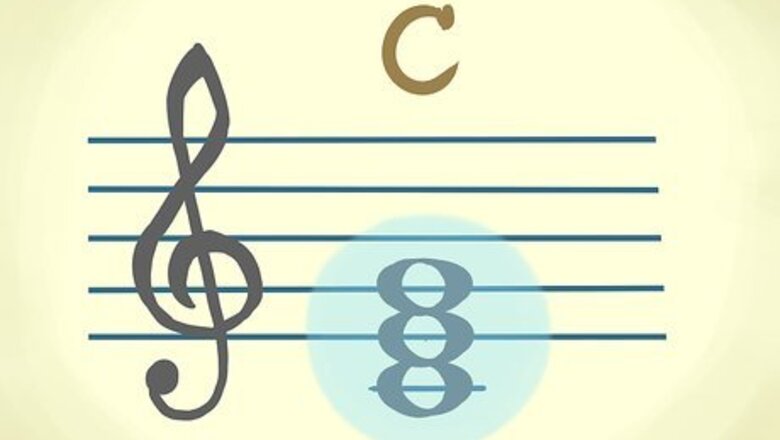
views
Chord Basics
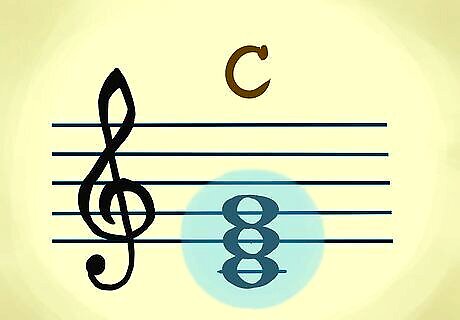
Understand what a chord is. A chord is three or more notes. Complex chords may have many notes, but you need a minimum of three. The chords discussed here will all be composed of three notes: a root, a third and a fifth.
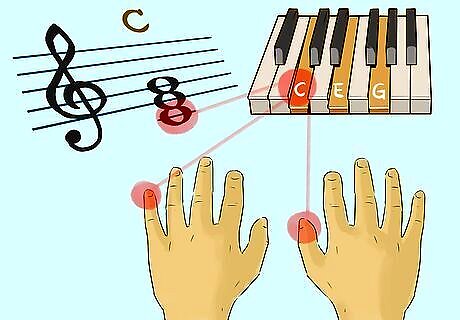
Find the root of the chord. Every major chord is built on a note called the tonic, or root of the chord. This is the note that the chord is named after and will be the lowest note in the chord. For a C major chord, C is the tonic. It will be the bottom note of your chord. You will play the tonic note with your thumb in your right hand, or with your pinkie in your left hand.
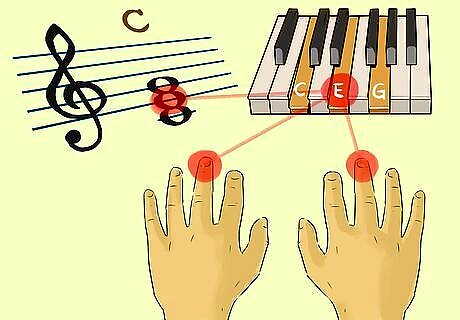
Find the major third. The second note in a major chord is the major third, which gives the chord its character. It will be four semitones, or half-steps, above the root. It is called a third because when you play a scale in that key, it will be the third note that you hit. For a C major chord, E is the third. It is four half steps above C. You can count them on your piano (C#, D, D#, E). You will play the third with your middle finger, regardless of which hand you’re using. Try playing the root and the third together, to get a sense of how that interval is supposed to sound. EXPERT TIP Melissa McDermott Melissa McDermott Music Instructor Melissa McDermott is a Musician and accomplished Social Media Manager at coBranding Studio based in New York City. She has over seven years of experience teaching piano and music theory, she currently works as a Piano Instructor at O DiBella Music Inc. Additionally, she specializes in creating meaningful, informative, and quality social media content for health and wellness brands and musicians. Melissa received her B.A. in popular music studies from William Paterson University. Melissa McDermott Melissa McDermott Music Instructor Major and minor chords are distinguished by the third note you play. The space between the 1st and 3rd notes — a minor third for minor chords, a major third for major chords — gives each chord its distinct sound. This small difference creates the overall mood, with major chords sounding brighter and minor chords more somber.
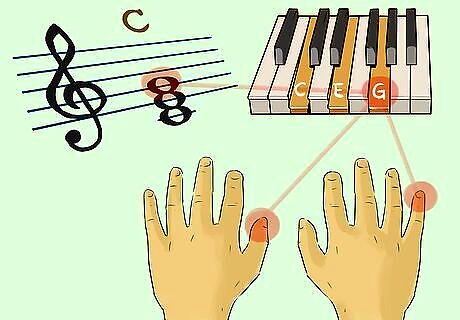
Find the fifth. The top note in a major chord is called the fifth because if you play a scale it will be the fifth note that you hit. It anchors the chord and makes it complete. It is seven semi-tones above the root. For a C major chord, G is the fifth. You can count the seven semi-tones up from the root on your piano. (C#, D, D#, E, F, F#, G.) You play the fifth with your pinkie in your right hand, or your thumb in your left.
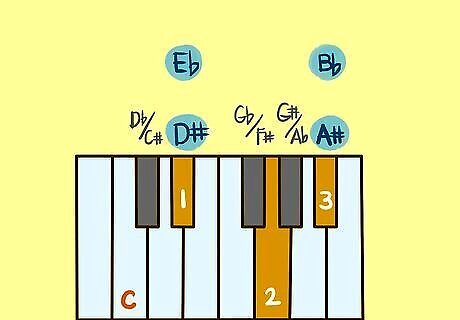
Understand that there are at least two ways to spell a chord. All notes can be written at least two different ways, for example Eb and D# are the same note. Therefore, an Eb major chord would sound the same as D# major chord. The notes Eb, G, Bb create an Eb chord. The notes D#, F???? (F##), A# create a D# Major chord, which sounds exactly like an Eb chord. The two chords are called enharmonic equivalents because they sound exactly the same but are written differently. A few of the common enharmonic equivalents are noted below, but otherwise the article presents only the most common notation of a major chord.

Review proper hand position. In order to play a piece of piano music well, you need to consistently use the correct hand position, even when you’re just practicing chords. Keep your fingers tall and curved, as if they are diving into the keys. Use the natural curve of your fingers. Use the weight of your arms rather than the strength of your fingers to push on the keys. Play on the tips of your fingers, including if possible the pinkie and thumb which tend to lie flat if you’re not paying attention. Keep your fingernails trimmed close so that you can play using the tips of your fingers.
Playing Chords
Use three fingers. Notice that you will only use fingers 1, 3 and 5 (thumb, middle, pinkie) to play the three notes of each chord. Your index and ring fingers may rest on, but not press down any keys. Notice that your fingers advance one half-step (one key) up the keyboard each time you change chords.
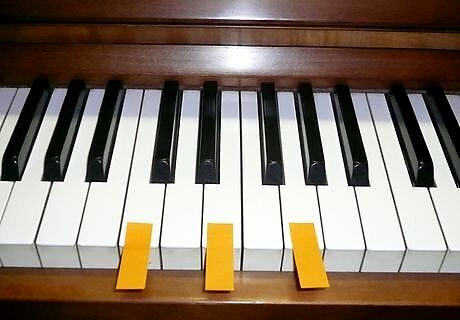
Play C Major. The three notes will be C, E, G. Remember, C = tonic (0), E = major third (4 semi-tones), G = fifth (7 semi-tones). Right hand fingering will place your thumb on C, your middle finger on E and your pinkie on G.C_Right_Hand_935.JPG Left hand fingering will place your pinkie on C, your middle finger on E and your thumb on G.C_Left_Hand_649.JPG
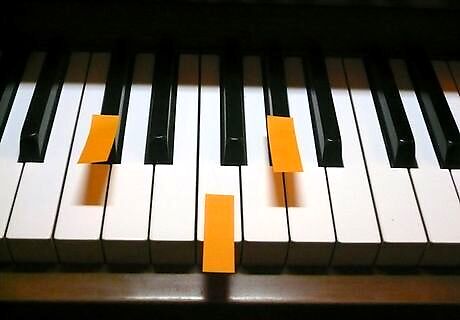
Play Db Major. The three notes will be Db, F, Ab. Remember, Db = tonic (0), F = major third (4 semi-tones), Ab = fifth (7 semi-tones). The enharmonic equivalent of this chord is C# Major. Notice that Db could also be noted as C#. F can also be written in music as E#. Ab can also be written as G#. The notes you play will be the same whether it is written as Db Major or C# Major. Right hand fingering will place your thumb on Db, your middle finger on F and your pinkie on Ab.C_Sharp__Right_Hand_670.JPG Left hand fingering will place your pinkie on Db, your middle finger on F and your thumb on Ab.C_Sharp_left_hand_633.JPG
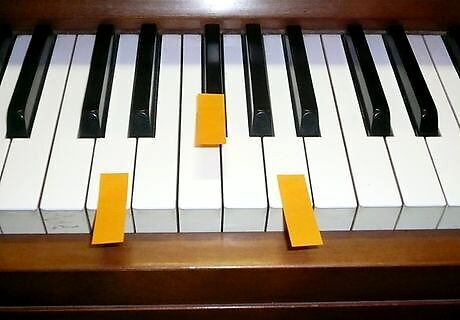
Play D Major. The three notes will be D, F#, A. Remember, D = tonic (0), F# = major third (4 semi-tones), A = fifth (7 semi-tones). Right hand fingering will place your thumb on D, your middle finger on F# and your pinkie on A. D_Right_Hand_428.JPG Left hand fingering will place your pinkie on D, your middle finger on F# and your thumb on A.D_Left_Hand_666.JPG
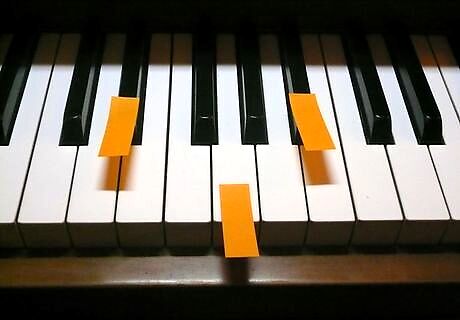
Play Eb Major. The three notes will be Eb, G, Bb. Remember, Eb = tonic (0), G = major third (4 semi-tones), Bb = fifth (7 semi-tones). Right hand fingering will place your thumb on Eb, your middle finger on G and your pinkie on Bb.D_Sharp_Right_Hand_772.JPG Left hand fingering will place your pinkie on Eb, your middle finger on G and your thumb on Bb.D_Sharp_Left_hand_939.JPG
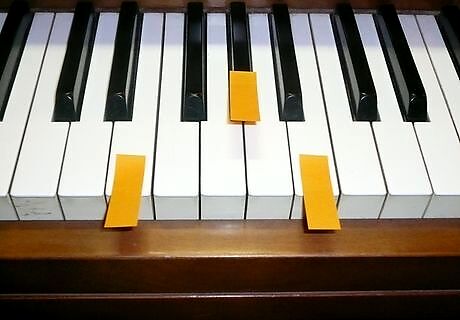
Play E Major. The three notes will be E, G#, B. Remember, E = tonic (0), G# = major third (4 semi-tones), B = fifth (7 semi-tones). Right hand fingering will place your thumb on E, your middle finger on G# and your pinkie on B.E_Right_Hand_300.JPG Left hand fingering will place your pinkie on E, your middle finger on G# and your thumb on B.E_left_hand_109.JPG
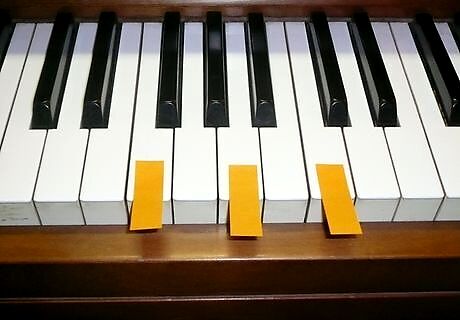
Play F Major. The three notes will be F, A, C. Remember, F = tonic (0), A = major third (4 semi-tones), C = fifth (7 semi-tones). Right hand fingering will place your thumb on F, your middle finger on A and your pinkie on C.F_Right_Hand_108.JPG Left hand fingering will place your pinkie on F, your middle finger on A and your thumb on C.F_Left_Hand_753.JPG
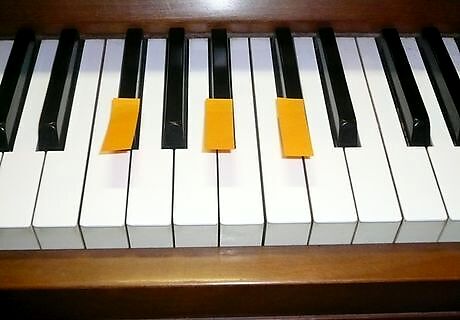
Play F# Major. The three notes will be F#, A#, C#. Remember, F# = tonic (0), A# = major third (4 semi-tones), C# = fifth (7 semi-tones). The enharmonic equivalent of this chord is Gb Major which will be written as Gb, Bb, Db. Note that F# can also be written as Gb. A# can also be written as Bb. C# can also be written as Db. So the notes you play to make a major chord will be the same in F# Major and Gb Major. Right hand fingering will place the thumb on F#, the middle finger on A# and the pinkie on C#.F_Sharp_Right_Hand_333.JPG Left hand fingering will place the pinkie on F#, the middle finger on A# and the thumb on C#.F_Sharp_Left_Hand_98.JPG
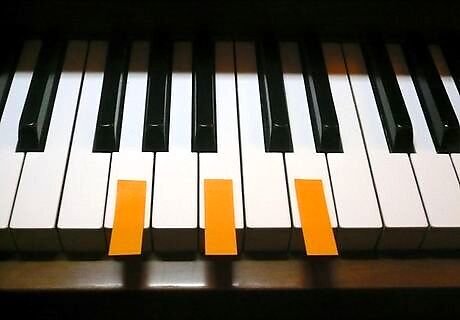
Play G Major. The three notes will be G, B, D. Remember, G = tonic (0), B = major third (4 semi-tones), D = fifth (7 semi-tones). Right hand fingering will place the thumb on G, the middle finger on B and the pinkie on D.G_Right_Hand_789.JPG Left hand fingering will place the pinkie on G, the middle finger on B and the thumb on D.G_Left_Hand_710.JPG
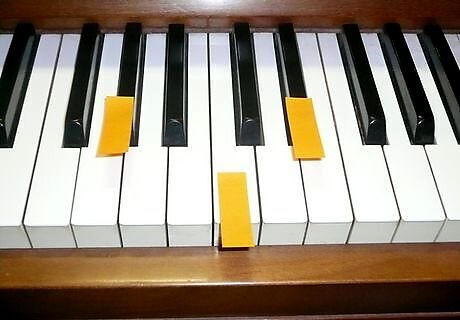
Play Ab Major. The three notes will be Ab, C, Eb. Remember, Ab = tonic (0), C = major third (4 semi-tones), Eb = fifth (7 semi-tones). The enharmonic equivalent of this chord is G# Major which will be written as G#, B#, D#. Note that Ab can also be written as G#. C can also be written as B#. Eb can also be written as D#. The notes you play to make a major chord will be the same for Ab Major and G# major, although they will be noted differently. Right hand fingering will place your thumb on Ab, your middle finger on C and your pinkie on Eb.G_Sharp_Right_Hand_592.JPG Left hand fingering will place your pinkie on Ab, your middle finger on C and your thumb on Eb.G_Sharp_Left_Hand_665.JPG
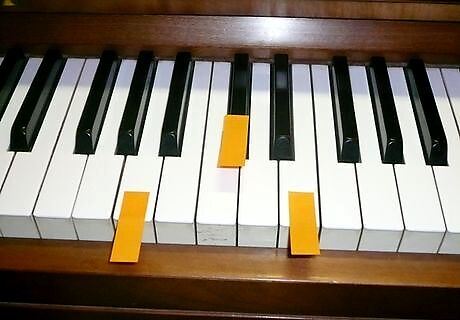
Play A Major. The three notes will be A, C#, E. Remember, A = tonic (0), C# = major third (4 semi-tones), E = fifth (7 semi-tones). Right hand fingering will place your thumb on A, your middle finger on C# and your pinkie on E.A_Right_Hand_536.JPG Left hand fingering will place your pinkie on A, your middle finger on C# and your thumb on E.A_Left_Hand_550.JPG
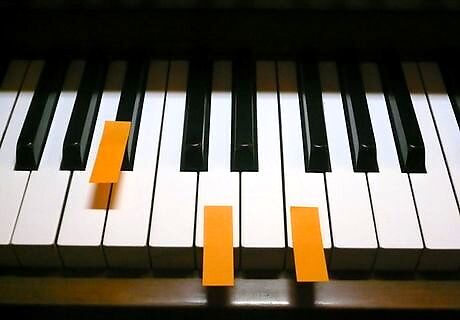
Play Bb Major. The three notes will be Bb, D, F. Remember, Bb = tonic (0), D = major third (4 semi-tones), F = fifth (7 semi-tones). Right hand fingering will place the thumb on Bb, the middle finger on D and the pinkie on F.A_Sharp_Right_Hand_53.JPG Left hand fingering will place the pinkie on Bb, the middle finger on D, and the thumb on F.A_Sharp_left_hand_581.JPG
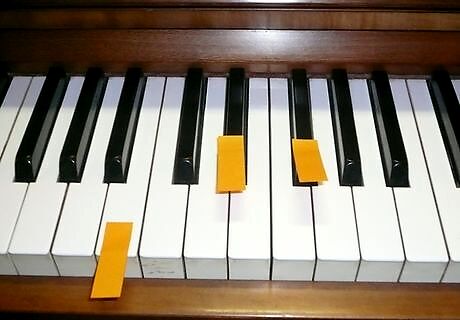
Play B Major. The three notes will be B, D#, F#. Remember, B = tonic (0), D# = major third (4 semi-tones), F# = fifth (7 semi-tones). Right hand fingering will place the thumb on B, the middle finger on D# and the pinkie on F#.B_Right_Hand_809.JPG Left hand fingering will place the pinkie on B, the middle finger on D# and the thumb on F#.B_left_hand_886.JPG
Practicing
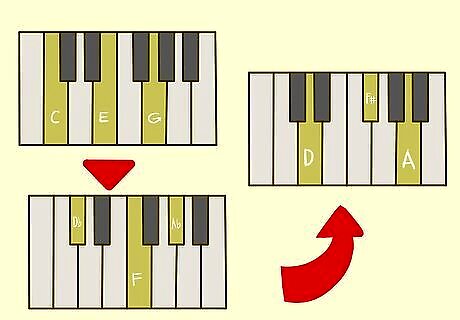
Practice playing all three notes at once. When you feel comfortable playing each chord individually, try skipping up the scale with each major chord. Start with a C major chord, then play a Db major, then D major and so on. Begin by doing this exercise with only one hand. When you feel confident, play both hands at once. Listen for false notes. The ratio between the notes should always remain the same, so if one chord suddenly sounds different, review whether you are hitting the correct notes.
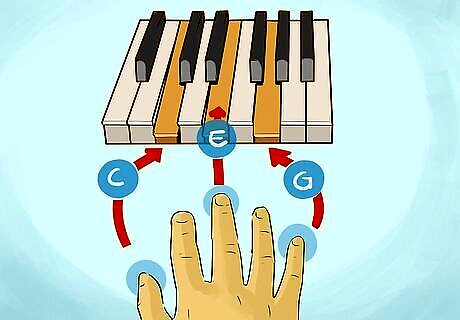
Try arpeggios. An arpeggio is when each note is struck in sequence from lowest to highest. To play a C Major arpeggio with your right hand, strike the C with your thumb and release. Strike E with your middle finger and release. Strike G with your pinkie and release. When you have mastered this motion, try to make it fluid rather than choppy. Strike and release each note quickly, so there is scarcely any time between notes.

Practice playing the major chords in different inversions. Inversions of a chord use the same notes, but place a different note on the bottom. For example, a C major chord is C, E, G. The first inversion of the C-major chord is E, G, C. The second inversion is G, C, E. Challenge yourself by making a major chord with every note on the scale, in every inversion.
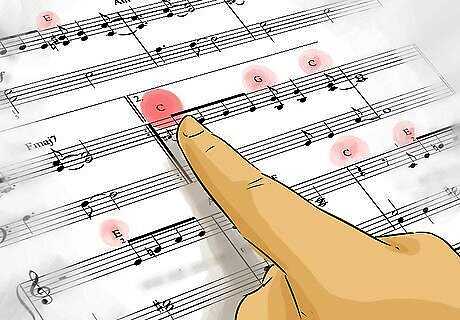
Look for chords in sheet music. Once you are familiar with how to construct and play a chord, find a piece of music that has chords written. Look to see if you can identify major chords that you have practiced.




















Comments
0 comment